

The Iraqi Jewish Rosh Hashanah Seder
Joe Ozer
United Kingdom
 On Erev Rosh Hashanah, Iraqi Jewish families will gather together to have a celebratory dinner to mark the new year. Before the meal, we say a multitude of prayers over specific foods – some we eat, some we don’t, but all have very important significance and symbolism. These are called the Yehi Ratzon prayers, which translates to “May it be Your Will.”
On Erev Rosh Hashanah, Iraqi Jewish families will gather together to have a celebratory dinner to mark the new year. Before the meal, we say a multitude of prayers over specific foods – some we eat, some we don’t, but all have very important significance and symbolism. These are called the Yehi Ratzon prayers, which translates to “May it be Your Will.”
- Dates – we say two prayers with two dates; the first is to thank G-d for the fruit of the tree – Borei P’ri Haetz. On the second date, we pray for an end to come to our enemies, haters and to those who wish evil upon us. The reason for this is that the Hebrew word for date is Tamar, which comes from the root Tam —to come to an end – which is what we wish on our enemies. Fresh dates are preferred over dried dates.
- Lubia (string beans) – again, two prayers are said with the beans. First, we thank G-d for the fruits of the ground – Boreh P’ri Ha-adamah. The second prayer asks for our merits to increase and states that G-d heartens us. This is because the words for beans – Rubia/Lubia has roots in the words Rab —meaning “many,” and Lev —meaning “heart.” So we wish for many good deeds and a warm heart. String beans are boiled till soft.
- Karti (chives) – this prayer is another one for our enemies, haters and those who wish evil upon us to be cut down. We don’t eat the chives; rather, we rip them in two. This is because the word for chives – Karti, has the same root as the word Karet – meaning “to cut.” No cooking of the chives is necessary.
- Silka (spinach) – this prayer’s symbolism comes from the root of the word in Hebrew for spinach. Silka is related to the word Selek, meaning “to depart,” which—you guessed it – is what we pray our enemies, haters and those who wish evil upon us to do. These are usually shallow-fried with onions and non-dairy yogurt.
- Karaa (courgettes) – this prayer has two requests. It wishes for all our evil verdicts to be ripped up, and for our good deeds to be announced before G-d. This is because the word Karaa means “to rip apart” in Hebrew – and it also shares the root with the word Kara, meaning “to announce.” Karaa are usually sliced and cooked till soft in a passata sauce.
- Apple Jam – Many Sephardic families don’t dip an apple in honey, as is the Ashkenazi tradition you may already be familiar with. We make apple jam; however, the prayer and symbolism are the same —the renewal of a sweet new year. See Florrie Raymond’s recipe below to cook your own home-made jam.
- Pomegranate – this is another one of the more familiar prayers; our good deeds are as numerous as the pomegranate’s seeds. Can be fiddly; it is much better if the pomegranate is opened and cut into smaller bunches.
- Beef (sheep) tongue – Some might know this prayer as a symbolic one using a fish or ram’s head. We eat a bit of tongue, so that we can pray to be the head and not the tail. Tongue cold cuts should be available from most good butcher shops.
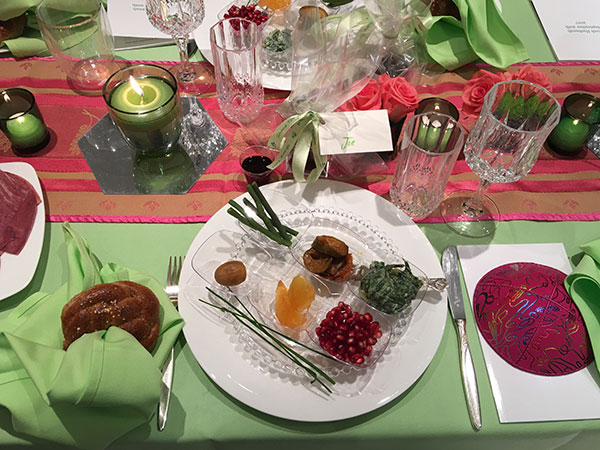
Below are all the Yehi Ratzon blessings for each of the above listed items (in Hebrew, with transliteration and translation into English) if you want to have a go this year!!
- בָּרוּךְ אַתָּה ה’ אֱלֹהינוּ מֶלֶךְ הָעוֹלָם בּוֹרֵא פְּרִי הָעֵץ. יְהִי רָצוֹן מִלְּפָנֶיךָ ה’ אֱלֹהינוּ וֵאלֵֹהי אֲבוֹתֵינוּ, שֶׁיִּתַּמּוּ אוֹיְבֵינוּ וְשׂוֹנְאֵינוּ וְכָל מְבַקְשֵׁי רָעָתֵנוּ
Baruch atah Adonai Eloheinu melech ha’olam borei pri haetz. Yehi ratzon milfanecha Adonai eloheinu v’elohei avoteinu she’yitamu oyveinu v’soneinu v’kol m’vaskshei ra’ateinu.
May it be Your will, G-d and the G-d of our ancestors, that there comes an end to our enemies, haters and those who wish evil upon us. - בָּרוּךְ אַתָּה יְ‑יָ אֱ‑לֹהֵינוּ מֶלֶךְ הָעוֹלָם בּוֹרֵא פְּרִי הָאֲדָמָה. יְהִי רָצוֹן מִלְּפָנֶיךָ ה’ אֱלֹהינוּ וֵאלֵֹהי אֲבוֹתֵינוּ, שֶׁיִּרְבּוּ זָכִיּוֹתֵינוּ תְלַבְּבֵנוּ
Baruch atah A-donay, Elo-heinu Melech Ha’Olam borei pri ha-adamah.
Yehi ratzon milfanecha Adonai eloheinu v’elohei avoteinu she’yirbu zakiyoteinu u’t’leivavenu.
Blessed are You, L-rd our G‑d, King of the universe who creates the fruit of the earth.
May it be Your will, G-d and the G-d of our ancestors, that our merits shall increase and that You hearten us. - יְהִי רָצוֹן מִלְּפָנֶיךָ ה’ אֱלֹהינוּ וֵאלֵֹהי אֲבוֹתֵינוּ, שֶׁיִּכָּרְתוּ אוֹיְבֵינוּ וְשׂוֹנְאֵינוּ וְכָל מְבַקְשֵׁי רָעָתֵנוּ
Yehi ratzon milfanecha Adonai eloheinu v’elohei avoteinu, she’yikartu oyveinu v’soneinu v’kol m’vakshei ra’ateinu.
May it be Your will, G-d and the G-d of our ancestors, that our enemies, haters, and those who wish evil upon us shall be cut down. - יְהִי רָצוֹן מִלְּפָנֶיךָ ה’ אֱלֹהינוּ וֵאלֵֹהי אֲבוֹתֵינוּ, שֶׁיִּסְתַּלְּקוּ אוֹיְבֵינוּ וְשׂוֹנְאֵינוּ וְכָל מְבַקְשֵׁי רָעָתֵנוּ
Yehi ratzon milfanecha Adonai eloheinu v’elohei avoteinu, she’yistalku oyveinu v’soneinu v’kol m’vakshei ra’ateinu.
May it be Your will, G-d and the G-d of our ancestors, that our enemies, haters and those who wish evil upon us shall depart. - יְהִי רָצוֹן מִלְּפָנֶיךָ ה’ אֱלֹהינוּ וֵאלֵֹהי אֲבוֹתֵינוּ, שֶׁתִּקְרַע רוֹעַ גְּזַר דִּינֵנוּ, וְיִקָּרְאוּ לְפָנֶיךָ זָכִיּוֹתֵינוּ
Yehi ratzon milfanecha Adonai eloheinu v’elohei avoteinu, she’tikra roah gezeira dineinu, v’yikaru l’fanecha zakiyoteinu.
May it be Your will, G-d and the G-d of our ancestors, that the evil of our verdicts be ripped, and that our merits be announced before you. - יְהִי רָצוֹן מִלְּפָנֶיךָ ה’ אֱלֹהינוּ וֵאלֵֹהי אֲבוֹתֵינוּ, שֶׁתְּחַדֵּשׁ עָלֵינוּ שָׁנָה טוֹבָה וּמְתוּקָה כַּדְּבָשׁ
Yehi ratzon milfanecha Adonai eloheinu v’elohei avoteinu, she’t’chadesh aleinu shanah tovah u’metukah ka’devash.
May it be Your will, G-d and the G-d of our ancestors, that You renew for us a year good and sweet like honey. - יְהִי רָצוֹן מִלְּפָנֶיךָ ה’ אֱלֹהינוּ וֵאלֵֹהי אֲבוֹתֵינוּ, שֶׁנִּהְיֶה מְלֵאִים מִצְוֹת כָּרִמּוֹן
Yehi ratzon milfanecha Adonai eloheinu v’elohei avoteinu, she’nihiyeh m’lei’im mitzvot ka’rimon.
May it be Your will, G-d and the G-d of our ancestors, that we be filled with mitzvot like a pomegranate [is filled with seeds]. - יְהִי רָצוֹן מִלְּפָנֶיךָ ה’ אֱלֹהינוּ וֵאלֵֹהי אֲבוֹתֵינוּ, שֶׁנִּהְיֶה לְרֹאשׁ וְלֹא לְזָנָב
Yehi ratzon milfanecha Adonai eloheinu v’elohei avoteinu, she’nihiyeh l’rosh v’lo zanav.
May it be Your will, G-d and the G-d of our ancestors, that we be a head and not a tail.
Photo of Joe Ozer by Blake Ezra Photography

Apple Jam
Florrie Raymond
United Kingdom
 Every year, ever since I was a little girl, my family would make Apple Jam for Rosh Hashanah. In Arabic, we’d call it Em’Rubbah and it would be eaten on challah on the eve of our Rosh Hashanah seder. This simple but traditional recipe has been passed down from mother to daughter in my family for generations in Iraq, and then in India, where my family emigrated before most of my family made Aliyah.
Every year, ever since I was a little girl, my family would make Apple Jam for Rosh Hashanah. In Arabic, we’d call it Em’Rubbah and it would be eaten on challah on the eve of our Rosh Hashanah seder. This simple but traditional recipe has been passed down from mother to daughter in my family for generations in Iraq, and then in India, where my family emigrated before most of my family made Aliyah.
Ingredients:
200 ml water
600 g granulated sugar
1kg apples cored seeded and quartered
7 whole cardamom pods
1 tbsp rose water
juice from 1 small lemon
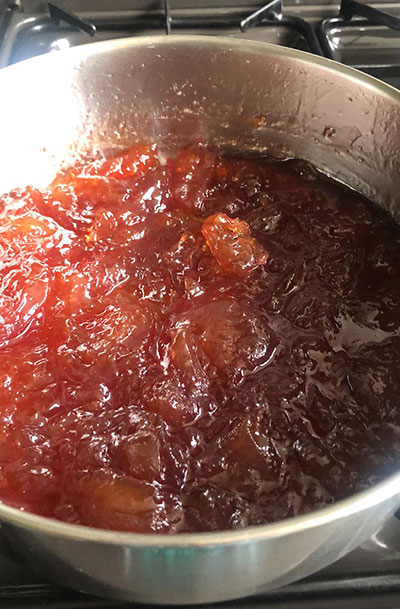 Directions:
Directions:
Combine sugar with water in a large saucepan. Simmer on medium heat, stirring until sugar dissolves.
Add apples, rosewater, cardamom pods and lemon juice. Bring back to a boil, then turn down to low heat and simmer, covered for 2 – 2.5 hours or until apples are soft and syrup is very thick.
Allow to cool completely before transferring to sterilised jars.
Store in the fridge

Round Challah
Eyla Benedykt
Brazil
 I don't usually spend hours in the kitchen but making Challah with my daughters before Rosh Hashana is a special tradition in our home. It’s a moment we share together which brings us closer to Hashem and fills us with joy for the new year. I look forward to continuing this tradition with my daughters and granddaughters L’dor Va’Dor, from generation to generation!
I don't usually spend hours in the kitchen but making Challah with my daughters before Rosh Hashana is a special tradition in our home. It’s a moment we share together which brings us closer to Hashem and fills us with joy for the new year. I look forward to continuing this tradition with my daughters and granddaughters L’dor Va’Dor, from generation to generation!
As we prepare the Challah with the best of intentions and wishes for our family, we extended those sentiments to you and yours for a sweet and prosperous new year.
Shana Tova U’metuka
Ingredients:
70 ml of warm water
50 g of sugar
15 g organic yeast
250 g of flour
1 teaspoon of salt
30 ml of oil
1 egg
1 whisked egg for brushing
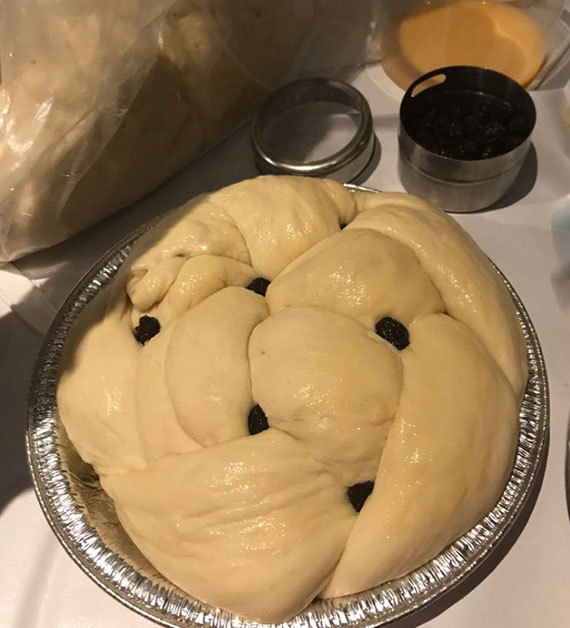 Directions:
Directions:
In a large bowl add the water, yeast and 1 Tablespoon of sugar, let stand for 10 mins.
Add egg and some of the flour and mix well.
Add the remaining flour, salt, oil and sugar. Mix by hand until dough is formed and knead for 10 mins. Form into a smooth ball and brush the top of the dough lightly with oil. Cover with plastic wrap and allow dough to rest until it has doubled in size.
Once dough has doubled, punch it down and divide it up to shape. Traditionally, challah baked for Rosh Hashana is round.
Brush the shaped or braided challahs with the whisked egg and garnish with desired toppings such as sesame, raisins, chocolate chips, etc.
Bake at 350 for half an hour.
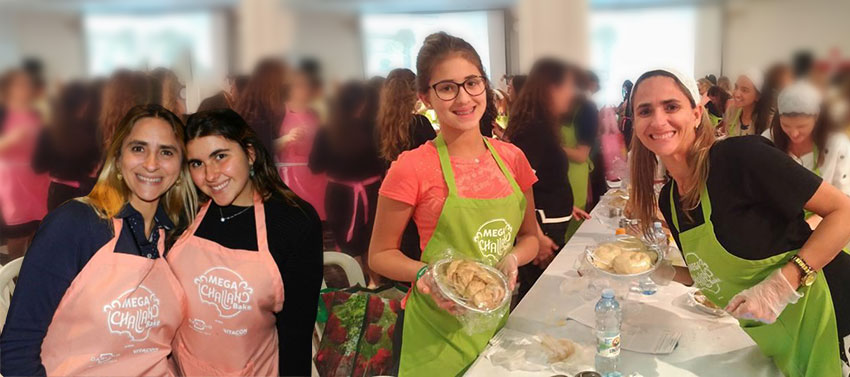
Photos of Eyla with her daughters Nicole (pink apron) and Tammy (green apron) at community challah bake
gatherings in Brazil.

Aunt Rozzie’s Matzo Balls (Or, The Best Matzo Balls)
Kimberly Ferenbok
Canada
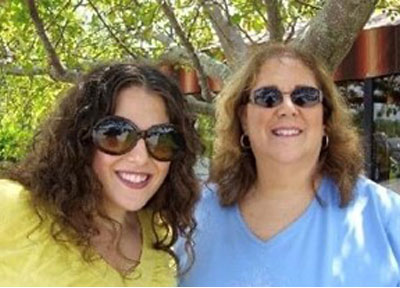 This is my paternal aunt’s recipe for Matzo Balls. Everyone says their recipe is the best, as if stating that fact, makes it so.
This is my paternal aunt’s recipe for Matzo Balls. Everyone says their recipe is the best, as if stating that fact, makes it so.
The Reason
What makes these matzo balls so dreamy and craveable? It’s the little pocket of fried onions in the centre of them. Cutting one in half reveals a small surprise of buttery, brown onions with little rivers of onion-y-ness bleeding into the broth. A stuffed matzo ball, if you will. They are a labour to make, but definitely a labour of love.
The Proof
But let me tell you a story about why this recipe is the best. My parent’s divorced in 1978, before I turned two. And as most divorces go, it was sufficiently acrimonious.
Fast forward to 2010, my mother was at the end of her battle with cancer. She wasn’t eating. Anything. I begged her, “Mom, there must be something! I’ll bring you whatever you want! There must be something you’ll eat. Häagen-Dazs? Curly fries? Cheesecake?” (All lifelong faves.) Reluctantly, my mother said, “Aunt Rozzie’s Chicken Soup with Matzo Balls”. Her ex-husband’s (of 32 years) eldest sister.
Not her mother’s, or grandmother’s recipe (both good cooks), but her ex-sister-in-law’s recipe. And my mother, of all her traits, was definitely loyal.
But I had never made them. So, I called my Aunt Rozzie and told her my mother’s request, and now mine, for the recipe. And like most amazing recipes, it was shared orally with vague approximations of pinches, dashes, and handfuls. The recipe that follows is a best effort of quantifying ingredients my Aunt Rozzie simply couldn’t define, despite my pleading that “some” was not a unit of measurement.
Over the years I have amended it, trying to get it exactly as I remember eating it as a girl. I hope I’m pretty close.
Though it might sound sad, my Aunt Rozzie’s matzo ball soup was the last meal my mother ate. It’s not sad to me. I love knowing my mother’s last meal was something she truly loved, and that had baked into it, many generations of Polish Jews making and passing on the same nourishment.
The Soup
This isn’t a soup recipe. Just a matzo ball recipe. Make chicken soup according to your own favourite recipe.
The Schmaltz
For the matzo balls, you need schmaltz (rendered chicken fat).
- The traditional method: buy a few pounds of chicken fat and skin from a butcher, cook it down with an onion letting it render, strain. With this, you also get the gribenes (delicious crunchy, crispy bits)—save them!*
- The laziest method: buy duck fat (or schmaltz—if you can find it).
- Or you can do it this way, which is what I usually wind up doing:
When I make chicken soup, I make it with a large, whole bird and I make an enormous pot. On the first night, I serve it with barley. And here’s why. When I make the soup, I do skim off the bits and foam that floats to the top, but not the fat. I purposely leave the fat. After we eat it on the first night, the pot goes into the fridge. On day two, I take out the pot and all of the fat has floated to the top and congealed. Using a spoon, I carefully remove it and set it aside for the matzo balls.
Ingredients for the Matzo Meal Mixture:
6 large eggs
½ cup room temperature or melted schmaltz + a few tablespoons more
6 tablespoons chicken soup
½ teaspoon white pepper
1½ teaspoons salt
1½ cups matzo meal
2 medium-sized yellow onions, diced
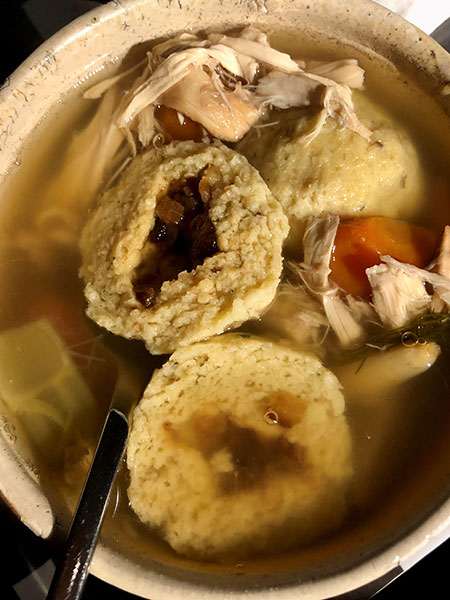 Directions:
Directions:
Lightly whisk eggs.
Add ½ cup schmaltz, soup, salt, and pepper. Whisk vigorously.
Add in matzo meal, bit by bit, until everything is combined.
Chill in fridge, covered, for 1 hour.
The Fried Onions
While mixture is chilling, heat a large skillet (nonstick works best) over medium heat with just enough schmaltz to cover the bottom
When the fat is hot, add the onions. You may increase the burner toward medium-high if necessary. The goal is not caramelized, onions, but fried. They burn easily so be prepared to stir them constantly until they’re done (10 minutes?). Once brown and crispy (I love some burnt bits!), remove from pan and set aside in a bowl to cool.
The Matzo Balls
After the matzo mixture has cooled, with greased hands, gather enough mix to make one matzo ball. Make a very crude ball shape, no need to roll and perfect.
Split the ball in half. Make an indentation with your finger making a small pit, inside one of the halves. Put about a (true) teaspoon of fried onions in the pit. The amount of onion may vary based on how large or small you make the matzo balls. I lean toward larger to allow for more onion. *If you have the gribenes referenced earlier, this is the time to add it in with the onions!
Add back the other half of matzo ball and press together. Roll ball between both palms, ensuring it is well-sealed.
Add matzo balls to a pot of generously salted, boiling water. After they’ve floated to the top, reduce heat to a low simmer, cover and let simmer for 30-40 minutes.
Serve and brag.

Chicken and Sweet Potato Soup
Nava Nadler
Germany
 The sweet potato in this soup brings in a slight sweetness suitable for Rosh Hashanah to make the New Year sweet. With turmeric for strengthening the immune system and saffron to help lift their spirits, this is a soup that I like to cook for my family, especially when one has a cold. This is a soup for that warms the soul when autumn comes around.
The sweet potato in this soup brings in a slight sweetness suitable for Rosh Hashanah to make the New Year sweet. With turmeric for strengthening the immune system and saffron to help lift their spirits, this is a soup that I like to cook for my family, especially when one has a cold. This is a soup for that warms the soul when autumn comes around.
Ingredients:
1 tablespoon olive oil
1 onion, diced
1 leek, diced
1 carrot, diced
2 sweet potatoes, peeled and diced
4 garlic cloves
1 teaspoon turmeric
1 teaspoon of saffron
6 cups chicken broth
2/3 cup Israeli couscous
4 chicken thighs
salt and pepper
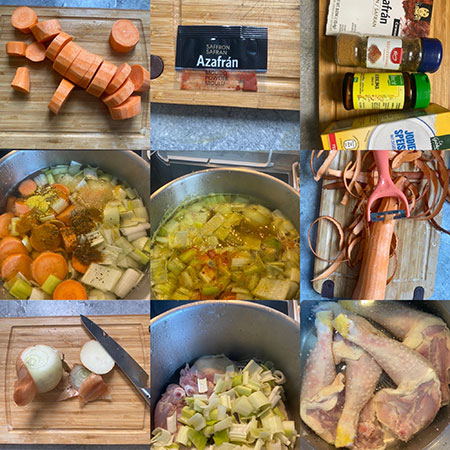 Directions:
Directions:
Heat the olive oil over medium-high heat.
Add onion, carrot and leek. Cook for 4-5 minutes until soft. Add the sweet potatoes and cook until lightly browned, 3-4 minutes. Add garlic, turmeric and saffron. Cook for 1 minute until fragrant.
Add chicken broth and let simmer. Cook for 10-15 minutes until the sweet potatoes are almost tender. Add the couscous and cook until tender, 9-11 minutes. Add the chicken.
Season with salt and pepper to taste.

Moroccan Fish
Rebecca Sufrin
Canada
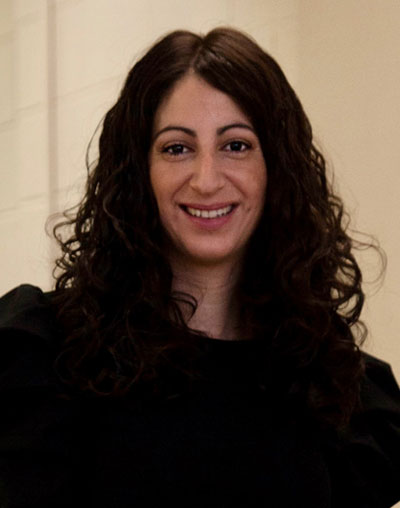 This dish is a staple at every shabbat dinner and holiday in Moroccan households, but every family recipe is slightly different. Below is the recipe my mother passed down to me, which her mother passed down to her. The delightful aroma of this recipe is a sure sign of yom tov or shabbat in our house.
This dish is a staple at every shabbat dinner and holiday in Moroccan households, but every family recipe is slightly different. Below is the recipe my mother passed down to me, which her mother passed down to her. The delightful aroma of this recipe is a sure sign of yom tov or shabbat in our house.
Wishing all a Shana Tova U’metuka.
Ingredients:
4-6 long sweet red peppers cut lengthwise in wide strips.
8-10 whole garlic cloves peeled.
2-4 tablespoons paprika in oil or sweet paprika.
4-6 fish filets - salmon, halibut or white fish. This recipe works well with most fish.
1/2 bunch fresh cilantro.
Salt to taste
Optional add-ins:
Dehydrated spicy chili peppers, carrot rounds, chickpeas, potato slices, olives, lemon–if using add towards the end).
 Directions:
Directions:
In a wide and high pan, or low pot over medium heat, add peppers, and garlic cloves. Season with salt, add water to cover about 2 inches above the peppers, and stir in the paprika. Here you can add any of the optional add-ins you would like. Cook the sauce until reduced by at least half, stirring occasionally.
Once the sauce is reduced, add fish and half the cilantro. Allow fish to cook for 6-7 mins uncovered, basting 3-4 times.
Gently flip the fish, add remaining cilantro, cover and cook for another 6-7 mins.
Remove from heat and enjoy.

Pkaila
Jonathan Touboul
France
 This dish brings back the best memories of our families and the traditions tying us to
This dish brings back the best memories of our families and the traditions tying us to
our roots.
Pkaila is a traditional Tunisian Jewish dish prepared for Rosh Hashanah. This dish is said to originate from the Kohanim (High Priests) who arrived in Djerba, Tunisia after the destruction of the first Temple. The Talmud mentions the dish made of white beans and spinach in several tractates as tavshil shel teradin or silka. In Tractate Shabbat 118b, it is called a “Shabbat delight”, but in our home, it is called a Rosh Hashana essential!
Wishing you and your family a Shana Tova U’metuka.
Ingredients:
10 pieces of prime rib or beef shank
3 marrow bones
10 tablespoons of fried spinach confit
1 ½ bunch of fresh mint, chopped
1 bunch of fresh coriander, chopped
1 bunch of dill, chopped
½ cup of dried mint leaves
1 teaspoon ground coriander
8-10 cloves of garlic, minced
1 or 2 tablespoons of Harissa
500g can white beans
Salt
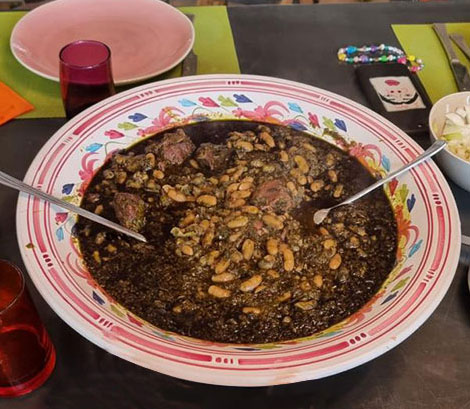 Directions:
Directions:
In a large pot, over medium heat, place all the ingredients, except the beans. Add water to cover. Place a lid onthe pot and cook for 1.5 hours.
You may have to adjust the seasoning before adding in the canned beans, this dish requires a good amount of salt to bring out the flavors of herbs. Add the canned beans and continue to simmer for 1 hour.
If you would like to thicken the liquid after the beans have simmered in the pot for an hour, you may add a slurry
(1 Tablespoon cornstarch diluted in 2 tablespoons water) just before turning off the burner.
This dish is best prepared a day or two before you plan on serving it.
Photo of Pkaila by Stephane Attal | Photo of Jonathan Touboul by Studio Maubeuge

Honey Ice Cream Nougat
Lisette Bengio
France
 Dear friends, shalom to all!
Dear friends, shalom to all!
I hope you all had a good summer! As we prepare for all the beautiful Tishrei celebrations, I’m reminded of a lovely gala dinner Israel Bonds held in the beautiful Jewish community of Metz in the East of France.
We spent a long weekend there visiting the region and enjoyed the community’s warm welcome and the wonderful Shabbat meals prepared by a great chef from the city who prepares food of Ashkenazi and Sephardic origin. I was able to obtain the chefs’ recipe for Honey Ice Cream Nougat that was served for dessert. I often prepare this to treat my family at Rosh Hashana.
Wishing you bon appétit, and may this new year be prosperous, sweet and full of joy for you and your dear Families!
Ingredients:
8 egg whites
160 g of warm honey
500 ml of whipping cream
100 g of crushed toasted almonds
50 g of pistachios
100 g of chopped toasted hazelnuts
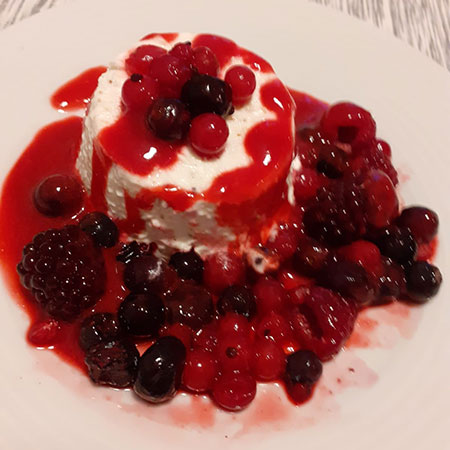 Directions:
Directions:
Whisk the egg whites until stiff, slowly incorporating the warm honey.
Whip the cream until stiff in a cold bowl.
Gently combine the two creams and add the mixed nuts.
Place the nougat in individual trays or ramekins and put in the freezer.
Serve with fresh fruit and fruit coulis, e.g., strawberries, raspberries, blueberries, etc., and decorate with a few fresh mint leaves.

Toffee Apple Cake
Orit Usharovsky
United Kingdom
 Last year, Israel Bonds and Manna hosted an online cooking event, during which participants received a really great recipe for a Toffee Apple Cake from Rebbetzin Margalit Dweck. Well, I tried to make it myself and I can say it was so easy to make, the whole family LOVED it and ordered me to make it a yearly staple for our Rosh Hashanah table. This cake is pudding-like in its softness, reminiscent of a sticky toffee classic.
Last year, Israel Bonds and Manna hosted an online cooking event, during which participants received a really great recipe for a Toffee Apple Cake from Rebbetzin Margalit Dweck. Well, I tried to make it myself and I can say it was so easy to make, the whole family LOVED it and ordered me to make it a yearly staple for our Rosh Hashanah table. This cake is pudding-like in its softness, reminiscent of a sticky toffee classic.
Ingredients
For the Cake:
125 g unsalted butter, softened, plus extra to grease
250 g self-rising flour, plus extra to dust
200 g dark brown soft sugar
2 Tbsp golden syrup
3 medium eggs
1 Tsp bicarbonate of soda
200 g coarsely grated apple (skin on): we use Pink Lady
125 ml apple juice
For the Toffee Icing:
100 ml double cream
75 g dark brown soft sugar
1 Tbsp golden syrup
Apple crisps optional
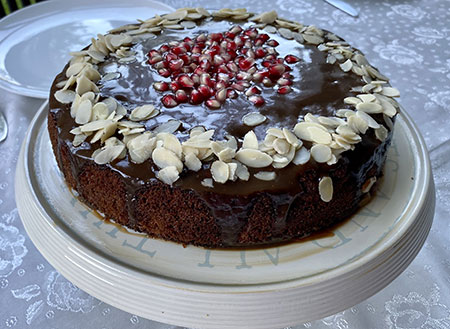 Directions:
Directions:
Preheat oven to 180oC (160oC fan). Grease a deep cake tin; dust with flour, tapping out excess).
Put butter and sugar into a large bowl and beat together using a handheld electric mixer until light and fluffy.
Whisk in the golden syrup, followed by the eggs, soda, flour, grated apple, and apple juice. It may look a little curdled, but don’t worry.
Pour mixture into the prepared tin and bake for 45 mins or until a skewer inserted into the centre comes out clean. Leave to cool completely in the tin.
Meanwhile, make the toffee icing. Put all ingredients into a pan. Heat gently and simmer for 7 mins, stirring occasionally, until thickened. Pour into a bowl and lay a piece of baking parchment on the surface to stop a skin from forming. Let cool.
Transfer cake to a cake plate or stand. Pour icing over top of cake, encouraging it to drizzle down the side. Decorate with apple crisps if you like. Serve in slices.
Photo of Orit by Blake Ezra Photography

Baklawa
Vicky Mamieh, Liz Cabasso and Linda Sirazi
Mexico
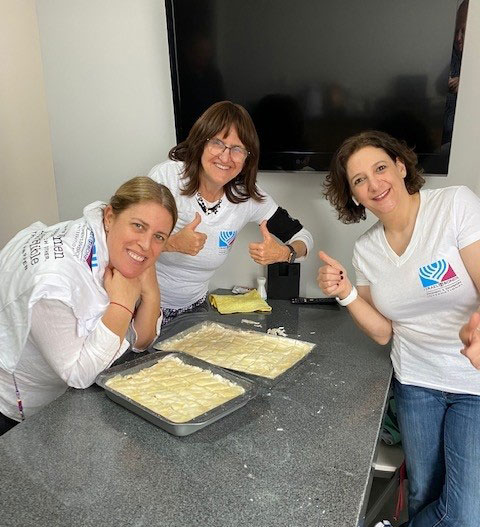 Israel Bonds Staff in Mexico, Vicky Mamieh and Liz Cabasso, together with Linda Sirazi Chair, Israel Bonds Women’s division in Mexico, gathered to make Baklawa and share the delicious dessert recipe with all our readers. This is a must have Rosh Hashana treat!
Israel Bonds Staff in Mexico, Vicky Mamieh and Liz Cabasso, together with Linda Sirazi Chair, Israel Bonds Women’s division in Mexico, gathered to make Baklawa and share the delicious dessert recipe with all our readers. This is a must have Rosh Hashana treat!
Ingredients:
1-2 packages of phyllo dough. Keep dough covered with plastic wrap, so it doesn’t dry and crack.
1 cup melted butter*
1 cup oil
Filling:
500 - 750 grams chopped walnuts
Cinnamon to taste
Sugar to taste
Syrup:
6 cups water
2 ½ cups sugar
8 drops lime juice
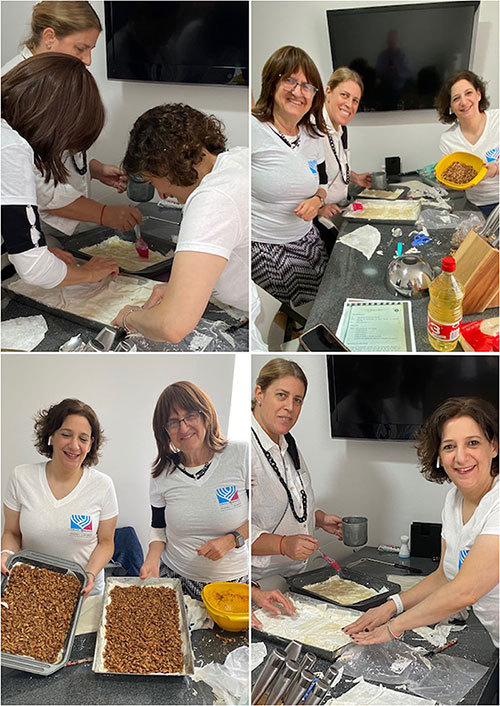 Directions:
Directions:
Preheat oven to 350° F.Combine oil and melted butter together.
Prepare the filling: In a separate bowl combine the nuts, cinnamon, sugar, and a little bit of the butter mix to moisten the filling ingredients.
Grease the sides and bottom of a large oven safe dish with the oil and butter mixture.
Place 1 sheet of phyllo dough and brush with the oil and butter mixture. Repeat this step several times layering and greasing the phyllo dough sheets each time. When you have a base with several layers of phyllo, add the filling in a thick layer evenly distributed across the dough.
Continue adding layers of phyllo dough brushing each layer with the butter and oil mixture until you have used up all the sheets of dough.
Using a sharp knife, cut into squares or diamonds, and brush top layer with butter and oil mixture. Bake until golden brown.
Prepare the syrup while baklawa is baking. Simmer all the ingredients until they thicken. Keep syrup hot until the Baklawa comes out of the oven and is fully baked.
Remove Baklawa from over and pour the hot syrup evenly over the entire surface so it is all absorbed.
*To make Baklawa pareve (non-dairy) replace butter with margarine.

